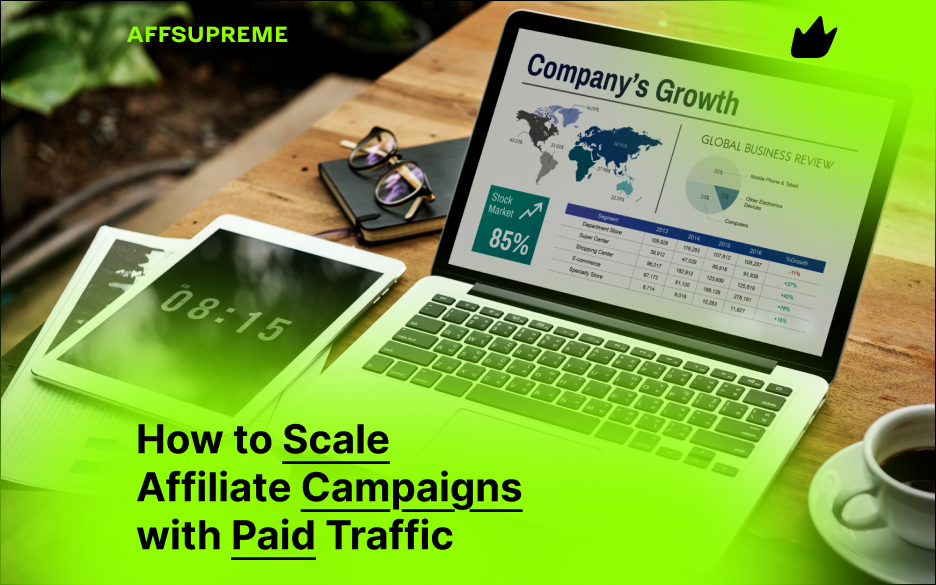Scaling affiliate marketing campaigns with paid traffic is one of the fastest ways to increase revenue — but it’s also one of the easiest ways to waste money if done without a strategy. With rising competition and ad costs in 2025, affiliates need a data-driven, structured approach to scale profitably.
This guide will walk you through:
-
The best traffic sources for scaling
-
How to build a high-converting funnel
-
Tracking essentials
-
Step-by-step scaling strategies that work
Why Use Paid Traffic to Scale Affiliate Campaigns
While SEO and organic reach are valuable long-term strategies, paid traffic offers immediate control, scalability, and faster testing. It allows you to:
-
Quickly validate offers
-
Reach precise audience segments
-
Control spend and track ROI
-
Optimize based on real-time data
However, successful scaling requires more than increasing budgets. You need the right offer, creative, funnel, and tracking in place.
Step 1: Choose the Right Traffic Source
Your offer type, target audience, and budget will determine the best traffic source. Here are some commonly used options:
-
Google Ads – Great for high-intent search traffic but often expensive.
-
Facebook and Instagram Ads – Good for visual or lifestyle products; works well for broad targeting.
-
YouTube Ads – Ideal for product education and high-trust purchases.
-
TikTok Ads – Best for trend-based, impulse offers.
-
Native Ads – Perfect for advertorials and long-form content.
-
Push Notifications – Low cost and high volume, but best for low-ticket, broad offers.
-
Reddit/Quora Ads – Excellent for targeting niche, engaged audiences.
Start with one or two platforms that align with your offer and scale from there.
Step 2: Build a High-Converting Funnel
Direct linking to affiliate offers rarely works well with paid traffic. Most networks disallow it, and it provides little control or room for optimization.
Instead, create a structured funnel that warms up the user before showing the offer. Some of the most effective models include:
-
Advertorial Page to Offer: A blog-style page that tells a story or shares a product experience, designed to pre-sell.
-
Quiz Funnel to Offer: Interactive quizzes that personalize the recommendation and drive engagement.
-
Lead Magnet to Email Follow-Up: Offer a free resource, collect emails, and promote affiliate products through automated emails.
-
Bridge Page to Offer: A simple, one-page intro to the product that sets up the affiliate offer contextually.
Your landing pages should match the tone of your ads, load quickly, and be mobile-optimized.
Step 3: Set Up Proper Tracking and Analytics
You can’t scale what you can’t measure. Accurate tracking is critical to optimizing campaigns and increasing ROI.
Tools to consider:
-
Affiliate tracking platforms like Voluum, RedTrack, or Binom
-
Google Analytics 4 for behavior tracking and broader insights
-
UTM parameters to segment traffic and analyze ad performance
-
Ad platform tracking (Facebook Pixel, TikTok Pixel, etc.)
Ensure you’re compliant with each ad network’s tracking and privacy policies to avoid account issues.
Step 4: Test Creatives, Angles, and Offers at a Small Scale
Before scaling, you must find a winning combination of:
-
Ad creative
-
Offer
-
Landing page
Use small budgets ($20–$100 per day) to A/B test different variations. Focus on testing:
-
Headlines and copy
-
Static images vs videos
-
Call-to-actions
-
Different emotional angles (urgency, fear, benefit-driven, curiosity)
Only scale campaigns that meet your performance benchmarks such as click-through rate (CTR), cost per acquisition (CPA), and return on ad spend (ROAS).
Step 5: Scale in Phases
Scaling too fast can break your campaigns. Instead, use controlled methods to expand.
Ways to scale:
-
Vertical Scaling: Gradually increase your ad budget by 10–20% per day.
-
Horizontal Scaling: Duplicate successful campaigns to new audiences, devices, or geographies.
-
Creative Scaling: Develop multiple variations of your best-performing ad creative.
-
Backend Scaling: Monetize through email marketing, upsells, or retargeting — not just front-end sales.
This multi-layered approach allows you to scale without losing control of performance.
Step 6: Stay Compliant
Affiliate campaigns are often scrutinized by platforms like Facebook, Google, and TikTok. Violating policies can get your account banned, even if your campaign is profitable.
To reduce risks:
-
Avoid deceptive claims or exaggerated results
-
Don’t use misleading before/after photos or unverified testimonials
-
Follow all advertising and affiliate policies for each platform
-
Always include a privacy policy, disclaimers, and terms on landing pages
Keeping your campaigns clean and transparent helps maintain ad account health and long-term scalability.
Key Metrics to Track When Scaling
To scale efficiently, keep an eye on the following key performance indicators:
-
CTR (Click-Through Rate) – Measures the relevance of your ad creative.
-
CPC (Cost Per Click) – Indicates how efficient your ad spend is.
-
CVR (Conversion Rate) – Measures how well your landing page converts.
-
EPC (Earnings Per Click) – Helps compare offer profitability.
-
ROAS (Return on Ad Spend) – Measures how much you’re earning for each dollar spent.
-
LTV (Customer Lifetime Value) – Important for long-term profitability, especially with email follow-ups or subscription offers.
The goal is not just to spend more — it’s to earn more while maintaining efficiency.
Final Thoughts
Scaling affiliate campaigns with paid traffic is highly effective — but only when done strategically. You need a validated funnel, well-tested creatives, reliable tracking, and a clear plan for gradual expansion.
Start by focusing on one channel, one offer, and one funnel. Test, optimize, and scale in layers. Monitor your metrics closely and be prepared to pivot as needed.
When done correctly, paid traffic can help you scale affiliate income to five, six, or even seven figures per month — fast.


